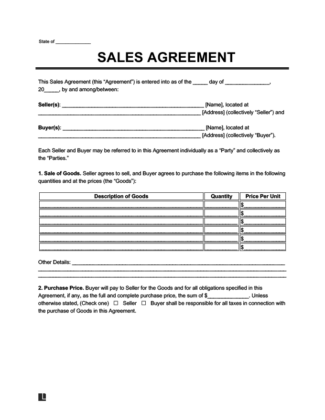
Use our Sales Agreement to record the sale of any item and protect both buyer and seller.

Updated May 18, 2024
Written by Josh Sainsbury | Reviewed by Brooke Davis
A sales agreement is a legally binding contract between a buyer and a seller that outlines the terms and conditions of a sale. Its purpose is to clearly define the expectations and obligations of both parties involved in the transaction.
In general, goods are something that you can use or consume that are moveable at the time of the sale, including watches, clothing, books, toys, furniture, and cars.
A sales agreement is a legally binding contract that outlines the terms of a sale where goods and services are exchanged. It involves two or more parties, including the seller and buyer, and identifies the items to be sold, the selling price, and all other relevant transaction details.
Sales agreements may be limited to isolated transactions for specific goods or may be used to create an ongoing sales relationship between parties.
Without a sales agreement, you may be unable to enforce the deal you made with the other party. Courts prefer a written contract when choosing whether to enforce it against a person or business. A written agreement also helps you know all your obligations and benefits as part of the transaction.
A sales agreement may also be called a sales contract or an agreement to sell.
If you’re looking for a Sales Agreement in Spanish, use our Acuerdo de Ventas.
Goods are movable property that can be sold in a sales agreement. This includes things like crops or stocks, for example. Different categories of goods can significantly impact the nature of the contract:
These goods physically exist when the seller and buyer sign the contract. They can be split into two subcategories:
Future goods don’t exist at the time the contract is signed. Instead, the goods must be manufactured or grown before they’re supplied to the buyer. A typical example is crops that aren’t yet developed. If a company wishes to buy corn from a farmer, it can purchase the right to the future product.
Contingent goods are a type of future goods but are based on a contingency. If those conditions are met, the buyer must purchase the goods listed in the agreement. If the conditions aren’t satisfied, the buyer isn’t required to pay for the goods.
Warranties are legally enforceable guarantees assuring the buyer that specific facts or conditions about the goods are accurate. Without a sales agreement, warranties may either apply automatically or not apply at all. Under the Uniform Commercial Code (UCC), there are two kinds of warranties — express and implied.
A seller creates an express warranty when they agree to replace or repair an item if its quality or performance isn’t as promised [1] .
An example is an electronics manufacturer that guarantees a television against defects for three years. The manufacturer must replace or repair the TV when a customer discovers and reports a fault.
Although a seller can create an express warranty even when they didn’t intend to, if the sales agreement describes the goods, the customer expects the goods will match that description. In this case, an express warranty is automatically created.
Similarly, if the seller provides the buyer with a sample of the goods, an express warranty is created – the goods will conform to the sample.
A written agreement allows both the seller and buyer to clearly state what express warranties will apply to the goods, if any.
An implied warranty is an unwritten promise that the goods will meet a minimum level of quality [2] . Buyers receive automatic warranties when they buy goods from a merchant. There are two implied warranties arising under the UCC:
Warranty of merchantability
A warranty of merchantability is created based on the agreement that the goods will work as expected.
For example, when a buyer purchases a bicycle for road cycling, there’s an implied warranty that the bike is suitable.
But if the buyer uses it for mountain biking, they aren’t using the bicycle for its intended purpose, and there’s no warranty of merchantability.
Warranty of fitness for a particular purpose
This particular warranty is created when:
An example is a homeowner buying paint to paint a house. Suppose a seller recommends a specific type of paint. But it turns out that color isn’t suited for homes. In this case, the seller breached the implied fitness warranty for a particular purpose.
Implied warranties don’t automatically apply if sellers exclude or modify them in a sales agreement.
A seller can expressly disclaim or modify implied warranties under the Uniform Commercial Code.
Risk of loss describes which party should carry the risk for damage to the goods after the completed sale but before delivery. If the seller accepts the risk of loss, they’ll have to send the buyer another shipment of goods. Or they can pay the buyer for damages if the goods are damaged before delivery.
If the buyer carries the risk of loss, they will have to pay for the goods even if they’re damaged during shipment.
Under Article 2 of the UCC, there are four risk-of-loss rules you should be aware of:
If you know you want to buy or sell certain goods but haven’t agreed on all the details or aren’t ready to sign a sales agreement; you can first sign a letter of intent to outline the terms and your agreement to negotiate.
A sales agreement is an important document that does more than record a transfer of ownership.
A sales agreement means you will document the sale price and payment information. Details such as a payment plan, down payment, closing costs, and late fees will all be included, and both parties will be contractually obliged to stick to the payment terms.
If the sale isn’t immediate, a sales agreement will hold both parties to their responsibilities to complete the sale at a later date, ensuring the sale goes through as planned. It also documents what should happen if the deal falls through.
Having the above written in a legally binding contract prevents miscommunication and resolves disputes. If neither party upholds the agreement, the document provides the buyer and seller with legal protection.
It’s essential to know the rights and duties of the buyer and seller when creating a sales agreement.
The buyer’s rights and responsibilities include the following:
The seller’s rights and duties include:
If your business sells goods or services to other parties or companies, you need a sales agreement. A professional sales agreement details the terms of the sale to help ensure that both parties understand.
You’ll want a written agreement to ensure smooth sailing until the exchange of money and goods. You and the other party will want to know what to do if there are any issues. This agreement can be used for various sales types, from small-scale purchases to large-scale contracts.
For specific sales contracts, the buyer has a statutory right to cancel the contract until midnight of the third business day after the sale. But this can only apply if the sale location is NOT the seller’s permanent place of business [4] .
Here are some examples of potential sellers and buyers who would need to use this agreement.
| POTENTIAL SELLER | POTENTIAL BUYER |
|---|---|
| Party supply store | Professional party planner |
| Clockmaker | Collector of specialty clocks |
| Office supply store | Start-up company |
| Car dealership | Rental car company |
| Winery | Wedding planner |
If you don’t have a sales agreement, you risk failing to understand:
This agreement lays a strong foundation and framework for a sale and details how to address and remedy problems should they occur.
Suppose you’re a successful individual or business. You want to maximize profits by anticipating extensive sales periods and purchasing the inventory needed to meet the demand. Without a sales agreement, you or your business may be unable to sell or secure inventory at the best prices, failing to maximize profits.
Your buyer may suddenly decide not to buy from you, leaving you with unexpected inventory and no recourse. Or your seller may find a buyer willing to pay more, leaving you with no inventory — and angry customers.
A simple sale of goods agreement can help guarantee the following:
| SELLER | Buyer |
|---|---|
| Guarantees the buyer will purchase a specific amount of goods | Guarantees the seller will supply a specific amount of goods |
| Guarantees the buyer will purchase the goods at a specific time | Guarantees the seller will supply the goods at a specific time |
| Guarantees the buyer will purchase the goods for a specific price | Guarantees the seller will supply the goods for a specific price |
| Guarantees the buyer will not back out of a promise after seller has devoted capital to produce the goods | Guarantees the buyer will be unaffected by market changes |
| Guarantees the buyer certain remedies should the seller breach | Guarantees the seller certain remedies should the buyer breach |
When writing a sales agreement, you can follow these steps to help you create an enforceable contract:
Please include the full name of the seller and buyer, their addresses, and other contact information.
For businesses, this should consist of the service of process information and the contact information of the officers or agents who will sign the contract. Be sure to include any additional buyers or sellers.
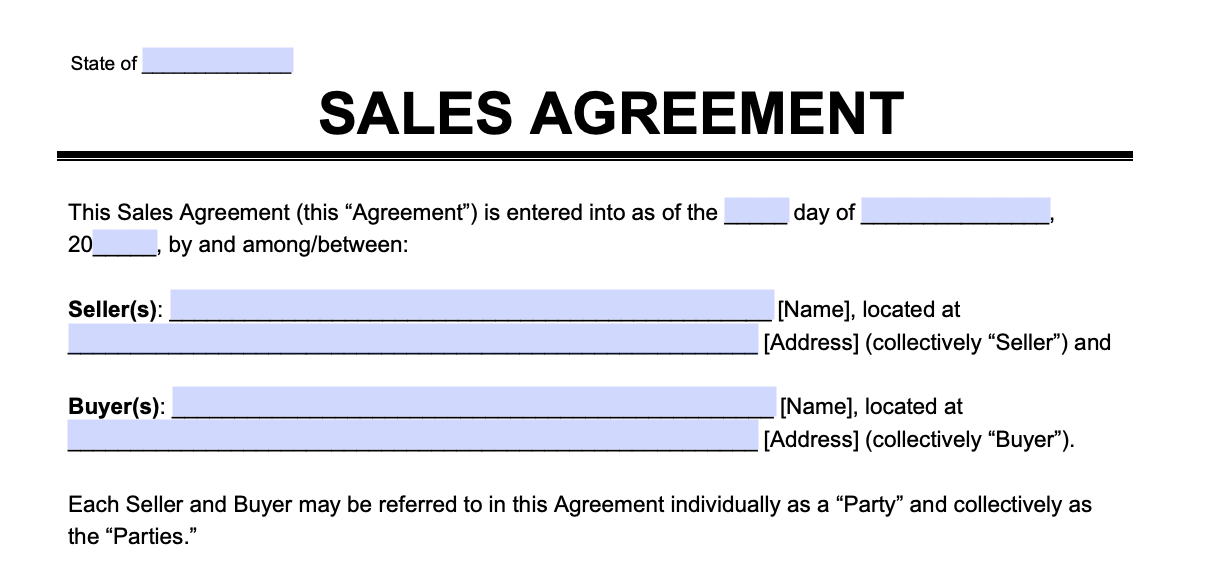
The contract should describe the goods sold. This should include:
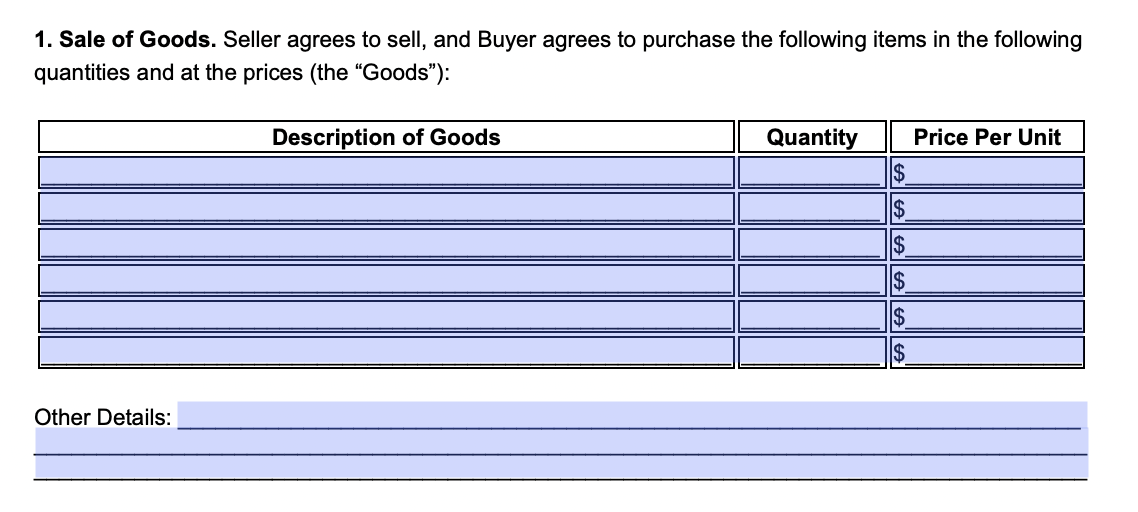
The contract for the sale of goods should include the price the buyer must pay for them. This consists of the flat rate for the goods or the cost per item outlined in the contract.
Any conditions or terms that affect the sale price should be clear. This includes information on who will pay taxes on the goods and how the buyer will make payment.
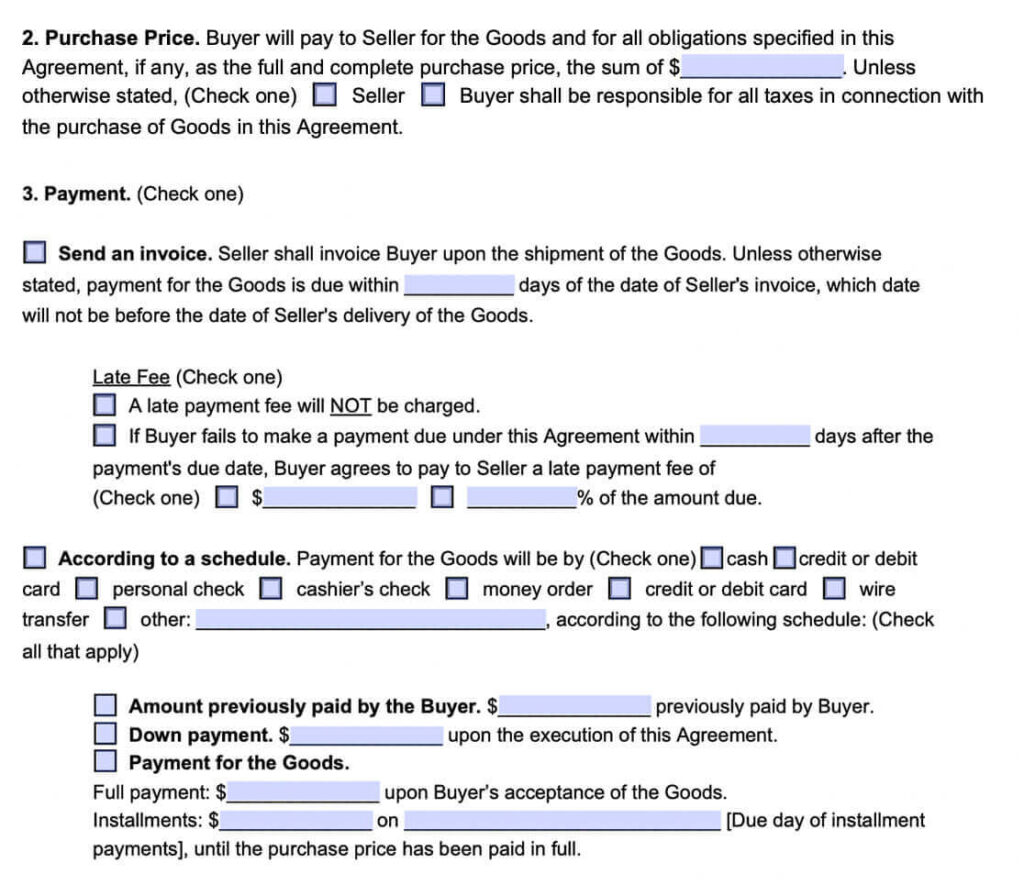
The contract should include how the seller will deliver the goods. Will they be shipped by the seller or picked up by the buyer? When are the goods to be delivered? These important questions require a clear answer.
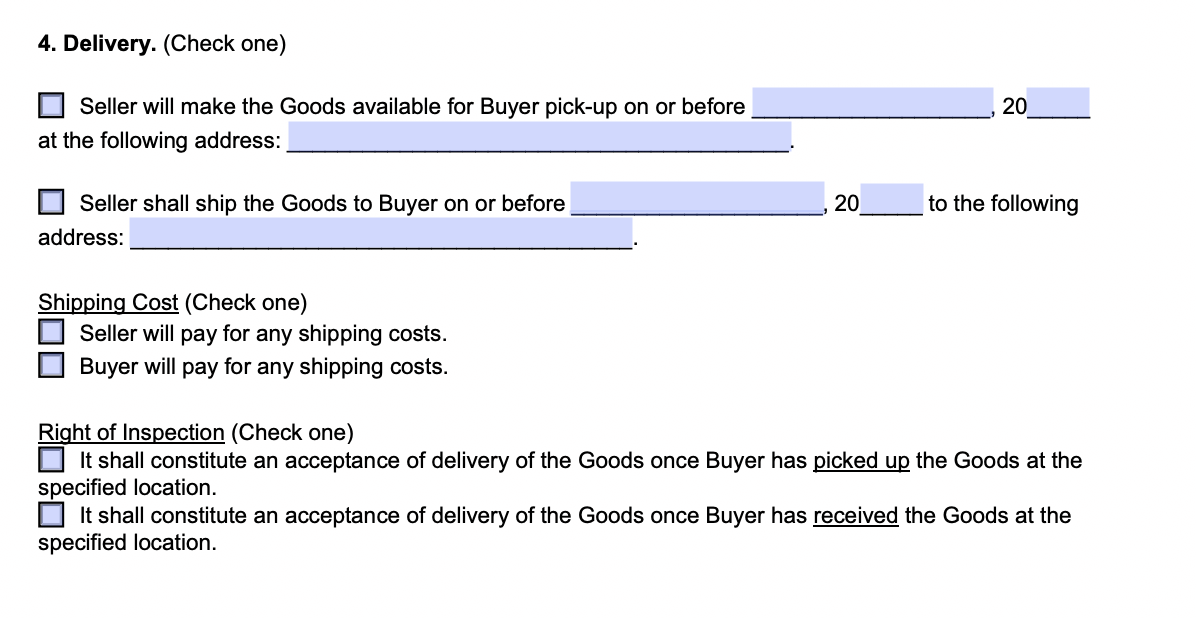
The contract should state when the risk of loss of the goods shifts from the seller to the buyer. This may be upon shipment or delivery.

The contract should include a provision as to whether the buyer can inspect the goods before delivery.
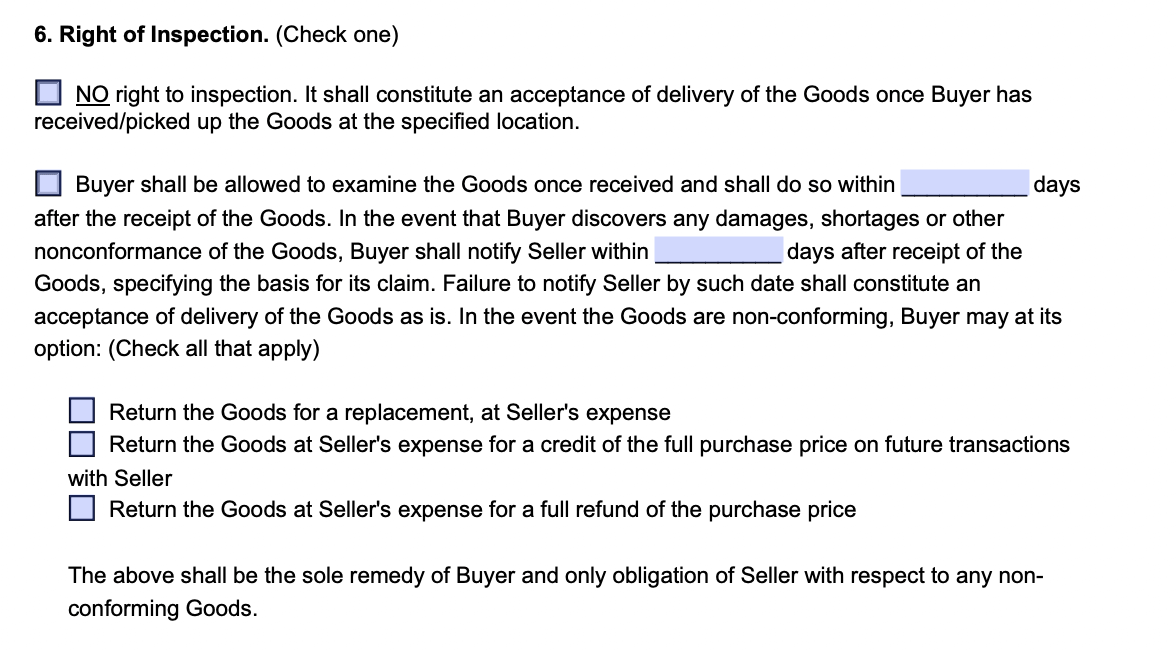
The warranties section should state what warranties cover the goods and disclaim any warranties the seller doesn’t wish to provide in the transaction.
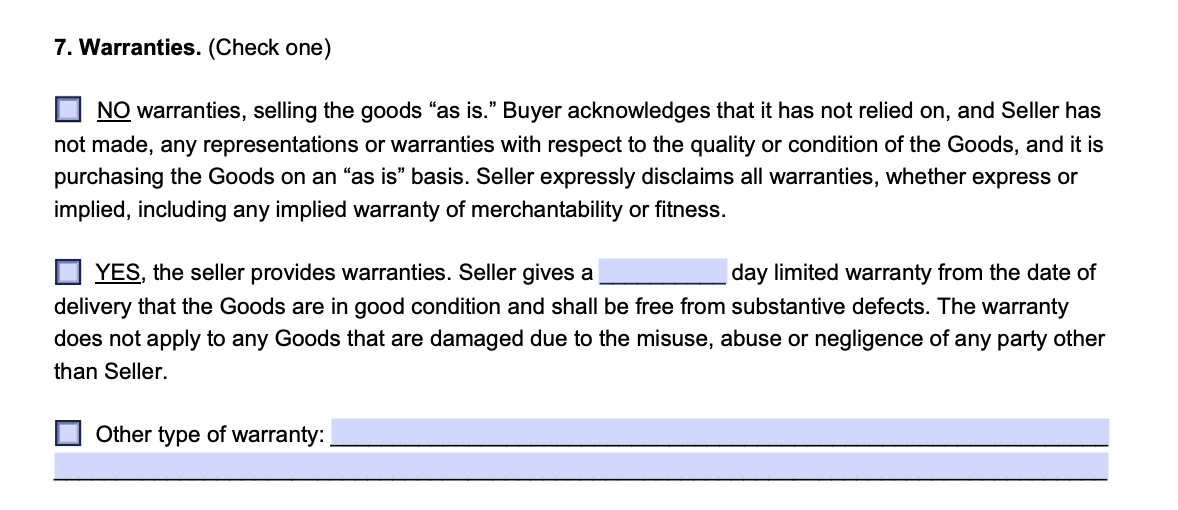
Either the buyer or the seller “assigns” or transfers its rights, obligations, or any benefits they will receive under this contract to a 3rd party.
For example, if the seller is a company that another company has bought, the seller may assign its rights under this contract to the new company. The new company would then be obligated to provide the goods to the buyer and receive payment.
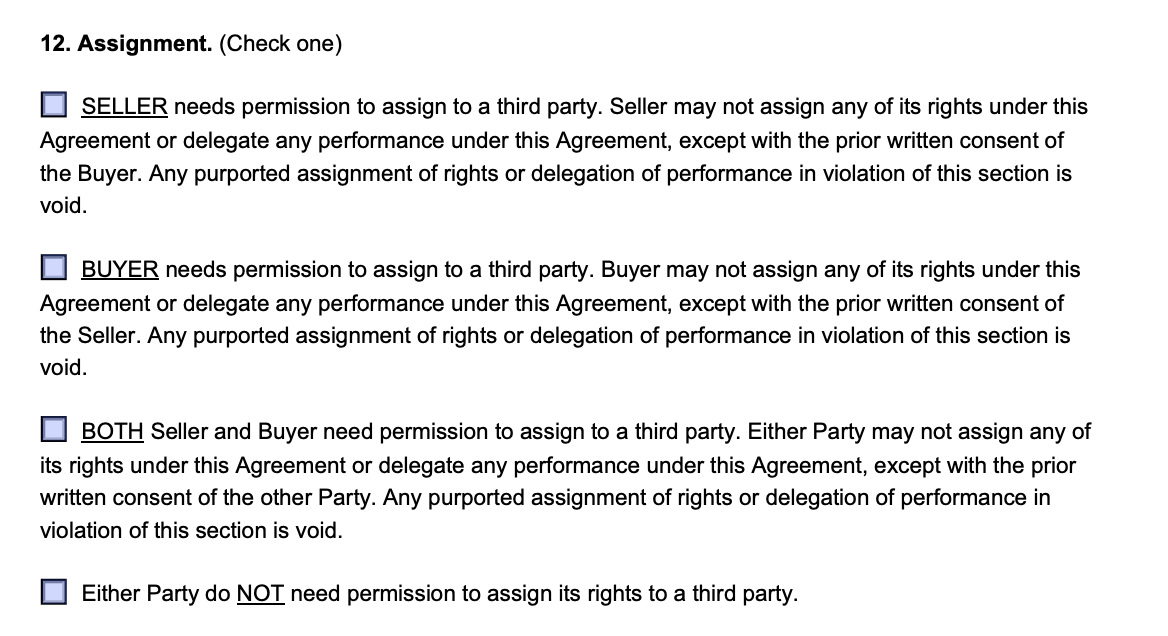
Many federal and state laws require a three-day cooling-off period for certain types of sales. [5] If this applies to your transaction, include the right to cancel language in the agreement.

The contract should address what will happen if there’s a dispute over the sales agreement. This should determine whether it will go to court, arbitration, mediation, or other potential resolution. It should also address the governing law of the contract and any venue provisions if necessary.
The dispute resolution options available are:
Court litigation occurs when a party files an action or claim in court. Each side presents its case or defense in a trial before a judge or jury, who determines the claim’s outcome. The decision by the judge or jury is final and binding.
Arbitration occurs when a neutral third party selected by the parties evaluates the dispute and determines a settlement. The arbitrator’s decision is final and binding.
Mediation – when a mediator, a neutral third party selected by the parties, tries to facilitate a compromise and agreement. The decision by the mediator is nonbinding.
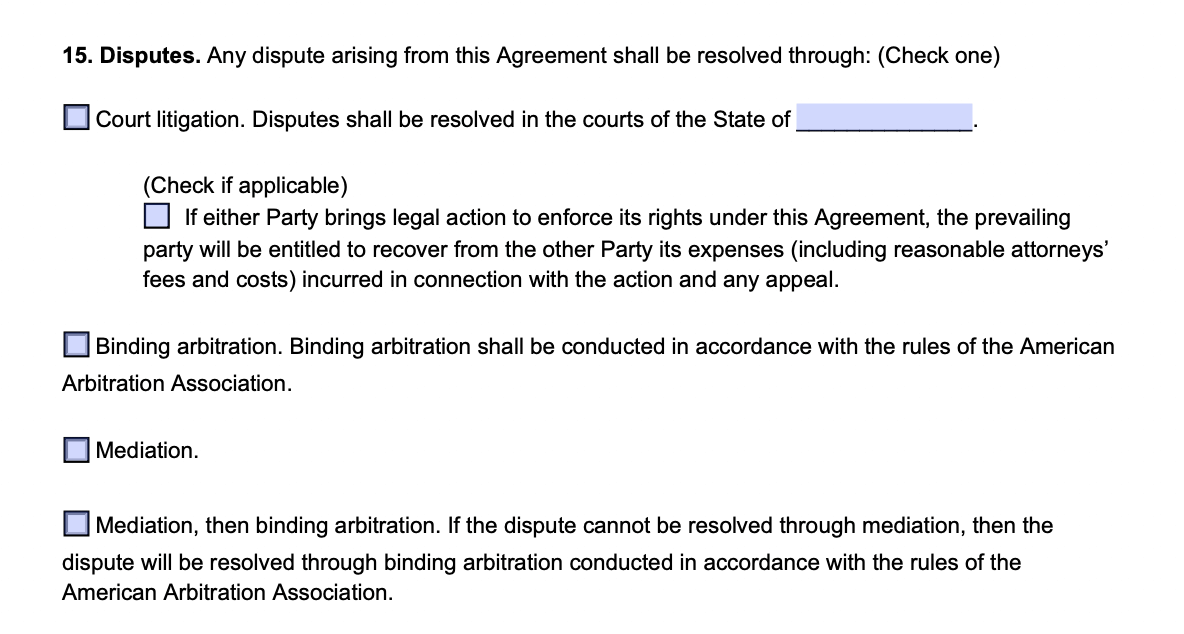
Finally, the seller’s and buyer’s signatures should be added to make the sales agreement legally binding.
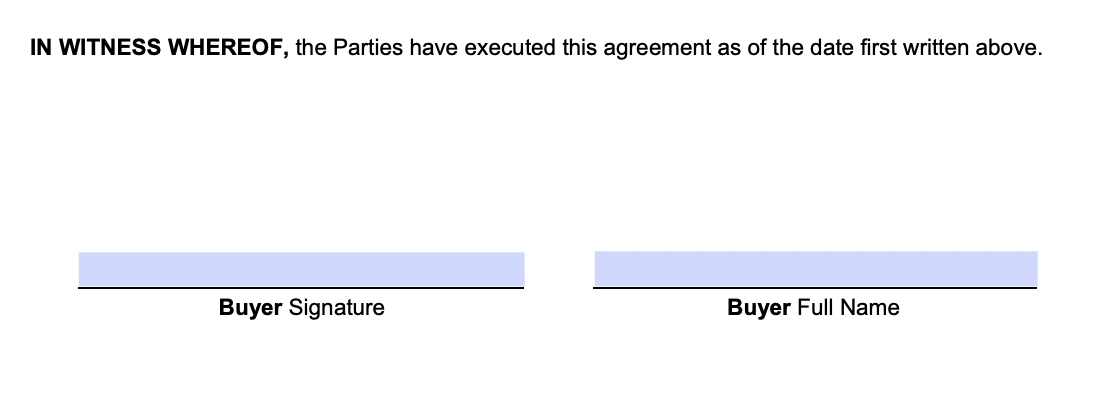
A well-drafted sales agreement will also include provisions for:
The sample sales agreement below details an agreement between a seller and a buyer. Under the terms specified, the buyer agrees to purchase items from the seller. You can also use our template builder to create your sales agreement step-by-step.